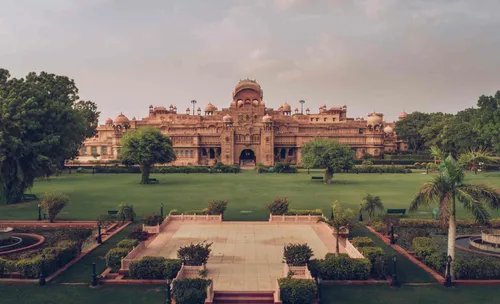
Laxmi Niwas Palace: The Opulent Heritage of Bikaner
Laxmi Niwas Palace, an epitome of grandeur and elegance, stands proudly in Bikaner, Rajasthan. This majestic palace, with its rich history and architectural splendor, offers a unique glimpse into the regal heritage of the Bikaner royal family. Here’s an in-depth exploration of Laxmi Niwas Palace, delving into its history, architectural features, and what makes it a fascinating destination.
A Historical Overview
Laxmi Niwas Palace was built between 1898 and 1902 by Maharaja Ganga Singh, the then ruler of Bikaner. Designed by British architect Sir Samuel Swinton Jacob, the palace served as a royal residence and was intended to reflect the Maharaja’s wealth and status. The palace was constructed using red sandstone and showcases a blend of Rajput, Mughal, and European architectural styles.
The palace has a storied past, having hosted various royal events and ceremonies. Over the years, it has been meticulously maintained and currently operates as a luxury hotel, offering visitors a taste of royal opulence.
Architectural Splendor
Design and Structure
Laxmi Niwas Palace is renowned for its distinctive architectural style, which combines traditional Rajput elements with European influences. The palace’s design is characterized by its intricate carvings, expansive courtyards, and luxurious interiors.
Facade and Entrance: The palace features a grand facade made of red sandstone, adorned with ornate carvings and decorative motifs. The entrance is marked by an impressive archway and intricate latticework, reflecting the artistic craftsmanship of the time.
Interior Elegance: The interiors of Laxmi Niwas Palace are equally opulent, with richly decorated rooms and suites featuring luxurious furnishings, elegant fabrics, and detailed artwork. The palace’s design includes high ceilings, large windows, and elaborate ceilings, showcasing a blend of Rajput and European styles.
Courtyards and Gardens: The palace includes several spacious courtyards and gardens, designed to enhance the overall grandeur of the estate. These areas feature manicured lawns, decorative fountains, and a variety of floral arrangements.
Notable Features
Architectural Fusion: The palace’s unique blend of Rajput, Mughal, and European architectural styles creates a harmonious and visually striking aesthetic. The use of red sandstone and intricate carvings adds to the palace’s elegance.
Royal Collection: The palace houses a rich collection of royal artifacts, including vintage furniture, antique art pieces, and traditional textiles. These items provide insights into the royal lifestyle and heritage of the Bikaner royal family.
Luxury Accommodations: As a luxury hotel, Laxmi Niwas Palace offers opulent accommodations and modern amenities. The rooms and suites are designed to reflect the palace’s historic charm while providing contemporary comforts.
Cultural and Historical Significance
Laxmi Niwas Palace holds significant cultural and historical value as a symbol of Bikaner’s royal heritage. It represents the grandeur and sophistication of the Rajput rulers and provides valuable insights into their lifestyle and traditions.
Key Attractions
Architectural Grandeur: The palace’s blend of Rajput, Mughal, and European design elements highlights the artistic achievements of the time. Its intricate carvings and elaborate interiors are particularly noteworthy.
Royal Heritage: Exploring the palace offers a glimpse into the regal lifestyle of the Bikaner royal family. The palace’s history and artifacts reflect the opulence and cultural richness of the region.
Scenic Beauty: The palace’s gardens and courtyards provide a serene and picturesque setting, enhancing the overall experience for visitors.
Tips for Visitors
Booking and Reservations: If you plan to stay at Laxmi Niwas Palace or dine at its restaurant, it’s advisable to make reservations well in advance. The palace’s luxurious accommodations and dining options are in high demand.
Dress Code: When visiting the palace, especially for dining or special events, it’s recommended to dress elegantly and respectfully. The palace’s refined ambiance calls for formal or smart-casual attire.
Guided Tours: Consider hiring a local guide to enhance your visit. Guides can provide detailed information about the palace’s history, architecture, and significance, offering valuable insights and anecdotes.
Photography: Photography is usually allowed, but be mindful of any restrictions, particularly inside certain areas of the palace. The palace’s exterior and gardens provide excellent photo opportunities.
Laxmi Niwas Palace in Bikaner is a magnificent example of royal grandeur and architectural elegance. Its unique blend of Rajput, Mughal, and European styles, coupled with its opulent interiors and rich history, makes it a standout destination. Whether you’re staying at the palace, exploring its royal artifacts, or simply admiring its beauty, a visit to Laxmi Niwas Palace promises an unforgettable experience. This historic jewel offers a glimpse into the splendor of Rajasthan’s royal past while providing modern luxury and comfort, making it a must-visit destination for travelers seeking a taste of regal opulence.
